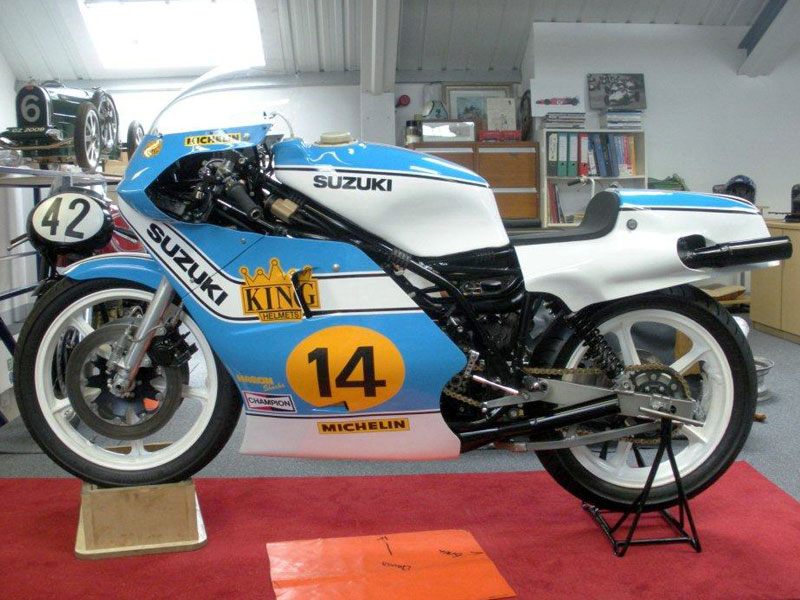|
|
1979 Suzuki RG500 Mk4

1979 Suzuki RG500 Mk4
Estimate: (£) 15,000 - 18,000
Reg Number: N/A
Frame Number: 11321
Engine Number: 11321
Body Colour: Blue / White
Cc: 500
MOT ExpiryDate: N/A
The introduction of the RG500 during 1976 had an immediate impact on the class, providing privateers who had previously been starved of competitive machinery with an effective mount to campaign at the highest level and consequently rejuvenating the 500cc class. Prior to the RG's introduction privateers had been forced to run over bored TZ twins or TR500's, however, the Mk I, which was clearly derived from the works machines first seen during the 1974 season gave those who could afford it a genuine "Grand Prix" motorcycle. The new machine retained the 56 x 50.5mm bore and stroke employed on the 1974 and `75 factory bikes, although for 1976, the works bikes had moved to "square" dimensions of 54mm x 54mm in 1976, a refinement that would not be incorporated into the "over the counter" racers until 1979 and the introduction of the MkIV. The Mk II, introduced for the 1977 season, incorporated detail changes, the most obvious being the more upright shock absorber mounting employed on the new model. Suzuki also followed the lead of the racers who had ridden the MK I variant and who had routinely dispensed with that models oil injection system, in deleting the system. The consequent switch to pre-mix lubrication on the Mk II which resulted in blanked off disc valve covers gracing the Mk II's crankcases and the exhaust system adopted integral silencers. The rest of the machine was little changed from the previous season, it retained the wire spoked wheels, quadruple 34mm Mikuni carburetors and four crankshafts of the Mk1 which delivered a power output reputedly of 103 bhp. The MK III, adopted a new seat unit and air assisted front forks but was largely unchanged from the previous season and was followed by the MK IV which adopted the square engine dimensions used by the original works bikes from 1976 onwards and new forks with 37 mm stanchions. The MK V of 1980 continued with detail changes when compared to the proceeding model. The swinging arm was braced and new expansion chambers were fitted, it in turn being replaced by the MK VI in 1981, the last of the "four crank" non stepped engined machines and the last RG to employ twin shock absorbers at the rear. Anti dive was added to the forks, the expansion chambers were once again revised and a modified fairing was fitted.
This example of the Mk IV variant is presented to a high standard in the traditional blue and white livery. It has benefitted from the fitment of a set of later (MK VI) forks equipped with anti dive and was at one time owned and ridden by Billy Guthrie.
Image and description kindly supplied by H&H Classic Auctions
Estimate: (£) 15,000 - 18,000
Reg Number: N/A
Frame Number: 11321
Engine Number: 11321
Body Colour: Blue / White
Cc: 500
MOT ExpiryDate: N/A
The introduction of the RG500 during 1976 had an immediate impact on the class, providing privateers who had previously been starved of competitive machinery with an effective mount to campaign at the highest level and consequently rejuvenating the 500cc class. Prior to the RG's introduction privateers had been forced to run over bored TZ twins or TR500's, however, the Mk I, which was clearly derived from the works machines first seen during the 1974 season gave those who could afford it a genuine "Grand Prix" motorcycle. The new machine retained the 56 x 50.5mm bore and stroke employed on the 1974 and `75 factory bikes, although for 1976, the works bikes had moved to "square" dimensions of 54mm x 54mm in 1976, a refinement that would not be incorporated into the "over the counter" racers until 1979 and the introduction of the MkIV. The Mk II, introduced for the 1977 season, incorporated detail changes, the most obvious being the more upright shock absorber mounting employed on the new model. Suzuki also followed the lead of the racers who had ridden the MK I variant and who had routinely dispensed with that models oil injection system, in deleting the system. The consequent switch to pre-mix lubrication on the Mk II which resulted in blanked off disc valve covers gracing the Mk II's crankcases and the exhaust system adopted integral silencers. The rest of the machine was little changed from the previous season, it retained the wire spoked wheels, quadruple 34mm Mikuni carburetors and four crankshafts of the Mk1 which delivered a power output reputedly of 103 bhp. The MK III, adopted a new seat unit and air assisted front forks but was largely unchanged from the previous season and was followed by the MK IV which adopted the square engine dimensions used by the original works bikes from 1976 onwards and new forks with 37 mm stanchions. The MK V of 1980 continued with detail changes when compared to the proceeding model. The swinging arm was braced and new expansion chambers were fitted, it in turn being replaced by the MK VI in 1981, the last of the "four crank" non stepped engined machines and the last RG to employ twin shock absorbers at the rear. Anti dive was added to the forks, the expansion chambers were once again revised and a modified fairing was fitted.
This example of the Mk IV variant is presented to a high standard in the traditional blue and white livery. It has benefitted from the fitment of a set of later (MK VI) forks equipped with anti dive and was at one time owned and ridden by Billy Guthrie.
Image and description kindly supplied by H&H Classic Auctions
1979 Suzuki RG500 Mk4
Advertisment
home | sitemap | motorcycle books
Copyright © 1997-2025 dropbears ![]()
